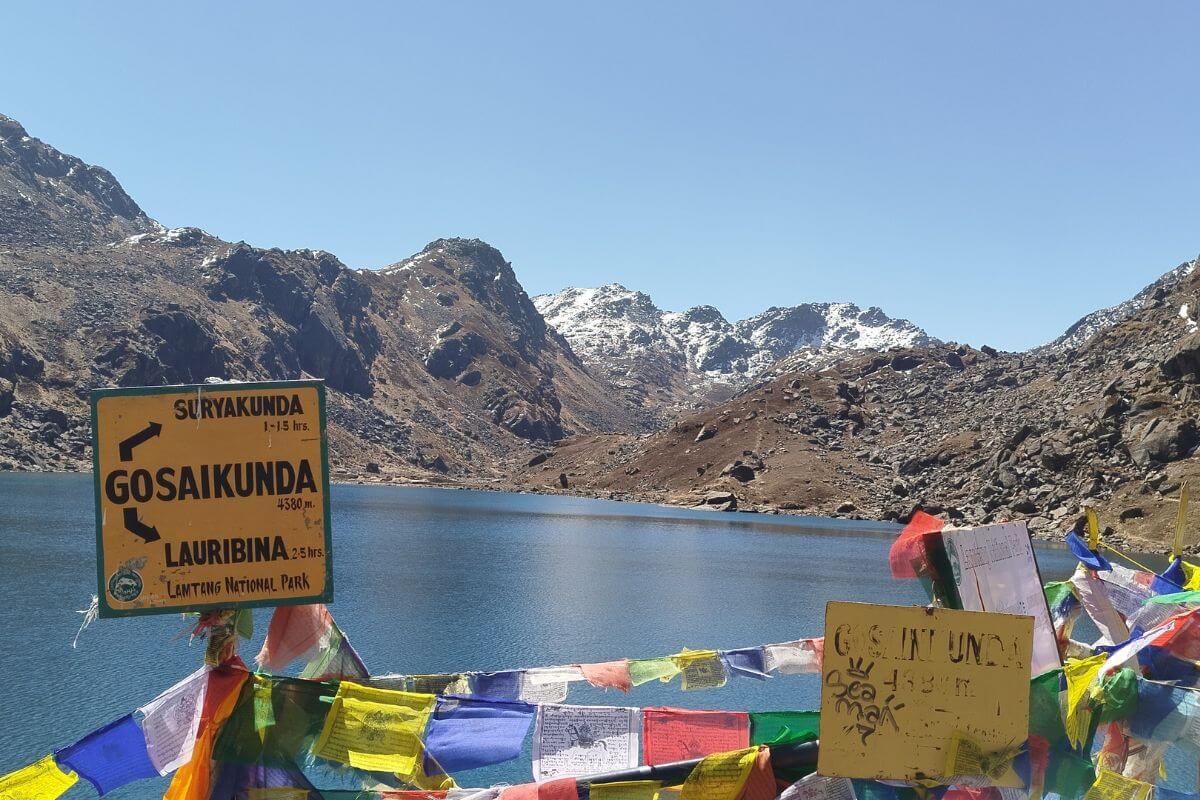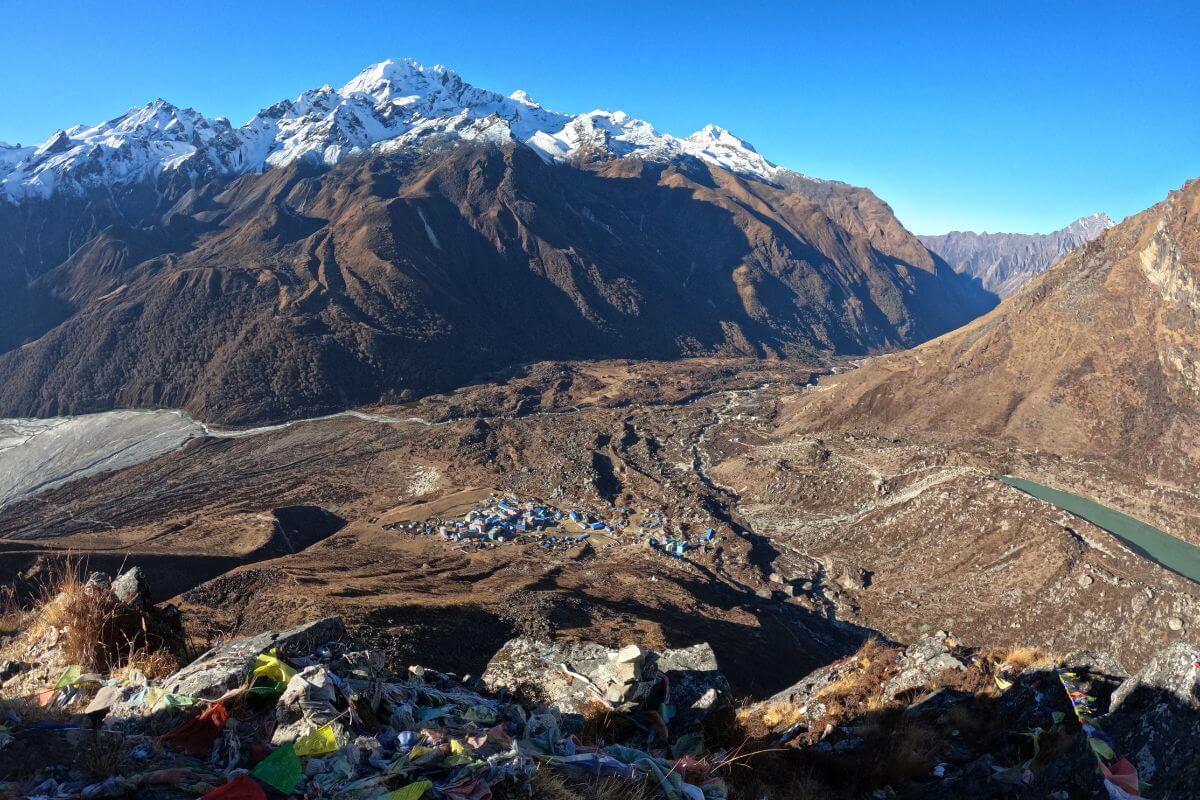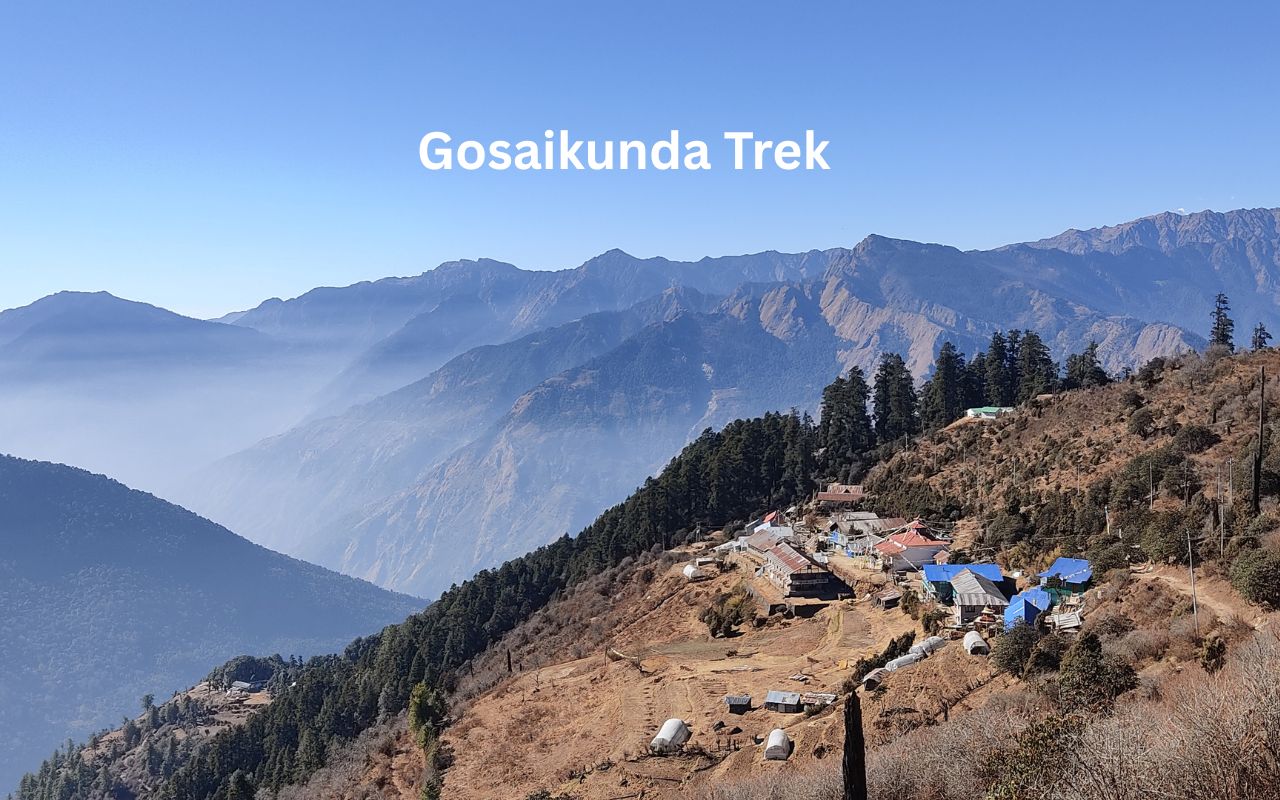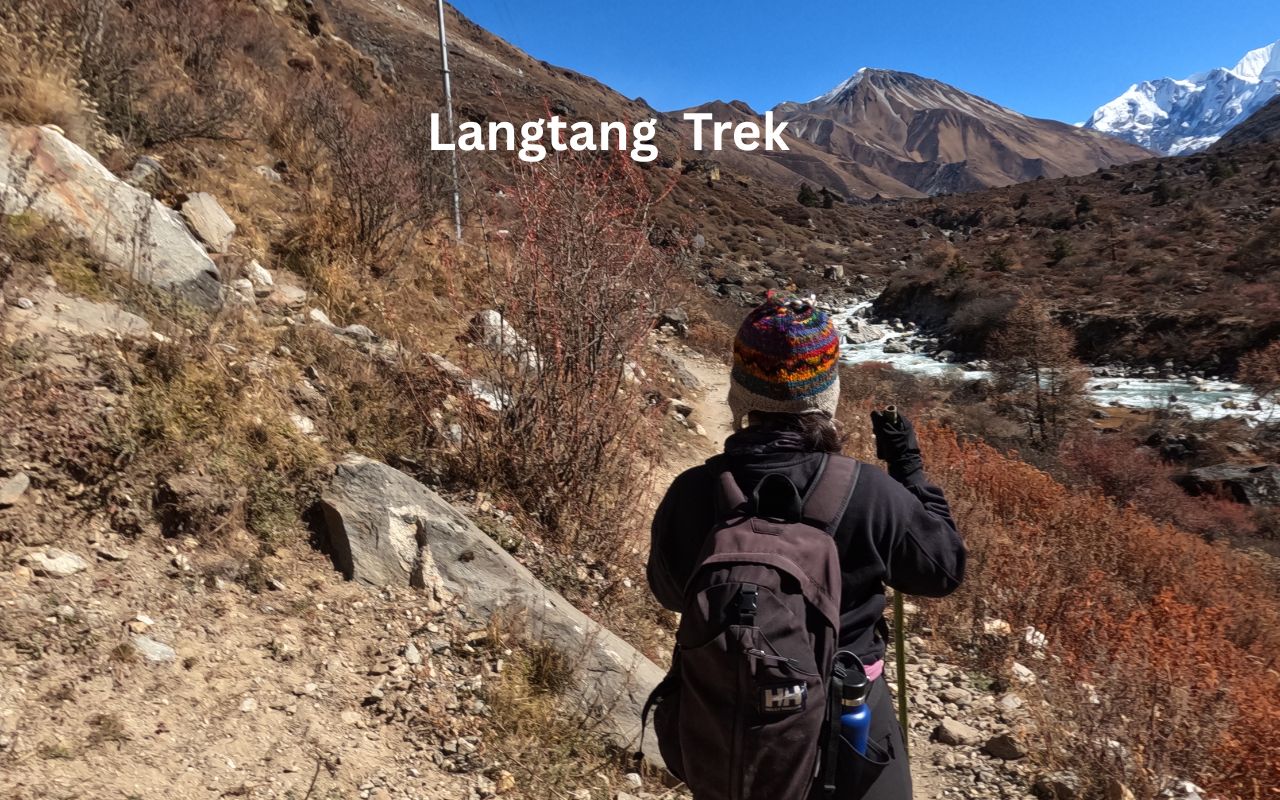Gosaikunda is perfect if you are short on time and want a spiritual, high-altitude experience with sacred lakes and dramatic views. But if you are looking for a deeper cultural journey through forests, glaciers, and Tamanag villages with more time to explore, Lamgtang is your go-to adventure.
Gosaikunda Trek vs Langtang Valley Trek | A Detailed Comparison
Table of Contents
Introduction of Gosaikunda vs Langtang Trek
Deciding between the Gosaikunda Trek and the Langtang Valley trek can be a bit overwhelming, but both offer unforgettable Himalayan experiences. Gosaikunda is perfect if you are planning a short trek (5-7 days), seeking spiritual lakes, alpine scenery, and lighter logistics.
In contrast, the Langtang trek, 7-10 days, offers a more immersive experience with diverse landscapes, vibrant Tamang culture, and optional high peaks like Tserko Ri.
How to reach Gosaikunda and Langtang Valley: Location, Distance & Travel Options compare
The accessibility and the location of legendary Gosaikunda and Langtang Valley are mentioned carefully so that it will be easier for you to get a clear picture of both treks. You will understand where the treks are located and how to get there.
Where is Gosaikunda located?
Gosaikunda is a sacred alpine lake situated in the Langtang National Park in Rasuma District, around 140 km north of Kathmandu. Nestled at an altitude of approximately 4380 meters, Gosaikunda is revered by both Hindus and Buddhists and draws trekkers and pilgrims alike.
Surrounded by rugged hills and glacial landscapes, it offers spiritual serenity and stunning views of the Ganesh Himal and Langtang ranges. The Gosaikunda Trek is considered moderately challenging but rewarding for its cultural significance and panoramic mountain beauty.
Where is Langtang Valley located?
Langtang Valley lies further northeast within the same Langtang National Park and is closer to the Tibetan border. Known as the “valley of glaciers,” Langtang Valley sits at elevations ranging between 2000 to 5000 meters, with Kyanjin Gompa(3870m) being one of its most famous landmarks.
It is a culturally rich trek, home to the Tamang people, with ancient monasteries, yak pastures, and dramatic alpine scenery.


How to reach the starting point of each trek
Both the Gosaikunda Trek and the Langtang Valley Trek are located in the Rasuwa District of Nepal, just north of Kathmandu. While they share the same general region, their starting points vary slightly. Most trekkers begin from either Dhunche or Syabrubesi during the Gosaikunda trek.
Dhunche is the most common trailhead if you are heading directly towards Gosaikunda Lake, while Syabrubesi is an alternative if you plan to combine the trek with the Langtang Valley or Helambu routes.
The Langtang Valley trek, on the other hand, almost always begins from Syabrubesi, which serves as the final road-accessible village before the trail heads into the high valley. From here, you will start ascending gradually through charming Tamang villages and lush forests toward the alpine settlement of Jyanjin Gompa.
Travel time from Kathmandu
Getting to either starting point involves a long but scenic drive from Kathmandu. Reaching Dhunche takes around 6 to 8 hours by local bus or private jeep, depending on road conditions. For Syabruni, the travel time is slightly longer; expect a 7-9 hour journey, especially during monsoon season when roads can become muddy or damaged.
Whether you are headed to Gosaikunda or Lamjung, it's a good idea to start early in the morning to make the most of the day and avoid traffic delays leaving the city. Hiring a private jeep, though more expensive, offers a more comfortable and faster alternative to crowded public buses.
How many days does it take to complete the Gosaikunda or Langtang Valley Trek
When choosing between the Gosaikund and Langtang treks, one of the first things to consider is how much time you have. These treks are both great options if you are looking to escape into nature, but they vary in length depending on your pace and chosen route.
How many days does each trek take?
The duration of your Gosaikunda or Langtang Valley trek depends largely on your itinerary, pace, and interest in cultural or scenic detours.
The Gosaikunda Trek typically takes 5 to 7 days. If you’re fit and short on time, the 5-day version includes key highlights like Lauribina and Gosaikunda Lake itself. The 7-day version is more relaxed, offering better acclimatization and scenic side trips.
The Langtang Valley Trek usually takes 7 to 10 days. A week-long trek gets you to Kyanjin Gompa and back, while a 10-day itinerary allows time to ascend Tserko Ri (5,000 meters) or visit Langshisha kharka for stunning glacier views.
Best options for short or longer treks
Short on time? Gosaikunda is your best bet. Its relatively short distance makes it ideal for trekkers who want to experience high-altitude lakes and panoramic views within a limited schedule. It's one of the best short treks in Nepal that still offers an immersive Himalayan experience.
Looking for a longer, more diverse trek? The Langtang Valley trek is perfect. The extended range of altitudes, ancient monasteries, and interaction with the local Tamang culture deliver a deeper, more varied journey. It’s a great option if you’re seeking both adventure and cultural immersion.
Is the Gosaikunda trek more difficult than the Langtang Valley trek?
Trekking in Nepal comes with varying levels of difficulty, and both the Gosaikunda and Langtang treks offer unique challenges based on altitude, terrain, and duration. Understanding the trek difficulty helps you prepare mentally and physically and choose the right route depending on your fitness and experience. Here’s a breakdown to help you decide which trial fits your trekking style best: the Gosaikunda or Langtang trek.
How hard is the Gosaikunda trek?
The Gosaikunda trek is considered moderately challenging. Although it’s not the longest trek, the rapid gain in altitude, especially while crossing the Lauribina Pass(4610m), can make it tough for first-timers. The trail is mostly well-marked but includes some steep climbs, particularly before reaching the sacred Gosaikunda Lake.
Good acclimatization and steady pacing are key to avoiding altitude sickness. If you’re trekking solo, being cautious of sudden weather shifts and limited emergency support is important.
How hard is the Langtang trek?
The Langtang Valley trek is also moderate but tends to be more forgiving due to its gradual altitude gain and relatively longer duration. Most trekkers reach a maximum elevation of around 3870m at Kyanjin Gompa, or up to 5000 m+ + if attempting the Tserko Ri summit.
The trail includes riverside paths, forest trails, and alpine meadows, offering natural rest points and more chances to acclimatize. It’s suitable for trekkers with a basic fitness level, but still requires preparation for long walking days.
Fitness level required
Both treks require a decent level of physical fitness. You don’t need to be an athlete but regular cardio workout(like hiking, running, or cycling), some strength training, and experience carrying a daypack will make the trek much more enjoyable.
Gosaikunda is better suited for trekkers with prior altitude experience or those with a shorter time frame. Langtang has longer days and diverse terrain. It is best for those seeking a more immersive Himalayan journey.
Trail conditions and terrain
The trails in both regions are mostly maintained by the local communities. Gosaikunda features stone staircases, rugged alpine paths, and glacier lakes. Langtang terrain extends its varieties from bamboo forests and landslide zones to high alpine valleys with panoramic views.
Both treks can be slippery during monsoon season or icy during winter, so it’s crucial to bring appropriate footwear, trekking poles, and clothing layers to adapt to the changing trail conditions. These treks are possible with proper planning, physical preparation, and the right mindset.
Which trek has a higher altitude and better acclimatization: Gosaikunda or Langtang
If you are planning a trek in the Himalayas, understanding altitude and how your body adjusts to it is very crucial. Both the Gosaikunda and Langtang Valley treks reach significant elevations that can affect even experienced trekkers if acclimatization isn’t handled properly. Here’s a humanised breakdown to help you choose the better-suited trek for your fitness and experience level.
The highest points in both treks
The Gosaikunda Trek reaches its highest elevation at Lauribina Pass (approximately 4610 meters), just beyond the sacred Gosaikunda Lake. This quick ascent in a relatively short trek makes it stunning but also more physically demanding.
On the other hand, the Langtang Valley Trek gradually climbs up to Kyanjin Gompa (3870 meters) and optionally to Tserko Ri (5000+ meters) for a viewpoint hike. The slower pace and optional summit make Langtang more flexible when it comes to high-altitude exposure.
Risk of altitude sickness
Both treks come with a moderate risk of Acute Mountain Sickness (AMS). However, Gosaikunda poses a slightly higher risk because of the fast elevation gain over just a few days. Langtang allows for a more natural acclimatization process due to its extended timeline and steady incline.
Which route you choose, it’s crucial to hydrate regularly, ascend slowly, and be honest with your body’s signals. Taking an extra rest day or descending if symptoms appear can make all the difference.
Which trek is better for first-time trekkers?
For first-time trekkers, especially those new to high altitudes, the Langtang Valley trek is generally a safer and more comfortable choice. It offers scenic rewards, gradual climbs, and the flexibility to turn back or pause. Gosaikunda, while shorter and deeply spiritual, demands a quicker acclimatization and more caution due to its higher passes.
If you’re short on time but fit and acclimatized, Gosaikunda is doable; otherwise, Langtang offers a gender introduction to trekking at elevation.
Which trek has better scenery and highlights: Gosaikunda or Langtang
One of the most exciting parts of choosing between the Gosaikunda and Langtang treks is comparing the visual and cultural treasures each trail has to offer. While both routes are located in Nepal’s Langtang region, their highlights are uniquely captivating in their own ways.
Whether you’re chasing alpine lakes, dramatic mountain views, or deep cultural immersion, here’s a humanized look at what you can expect on each trek.
What will you see on the Gosaikunda trek?
The Gosaikunda Trek is best known for its series of sacred alpine lakes, especially the main Gosaikunda Lake, which sits at 4380 meters. Surrounded by rocky hills and reflecting the sky, the lake is a spiritual hub for both Hindus and Buddhists.
Along the way, you’ll trek through dense rhododendron forests and charming Tamang villages and pass open ridges that offer jaw-dropping views of the Langtang and Ganesh Himal ranges.
During spring, the trails bloom with wildflowers, and in autumn, the visibility is at its finest. It’s a relatively short trek that delivers high-altitude drama and sacred serenity.
What will you see on the Langtang trek?
The Langtang Valley Trek, on the other hand, is more immersive and diverse. It starts with thick forests full of red pandas, langurs, and lush vegetation, eventually opening up to a glacial valley framed by snow-capped giants like Langtang Lirung.
The cultural journey is just as rich- expect to pass through Tamang and Tibetan-influenced villages like Langtang and Kyanjin Gompa, where prayer flags flutter and yak herders go about their day.
You’ll also have the chance to explore glacial moraines, monasteries, and panoramic viewpoints like Tserko Ri. It’s a scenic and cultural deep dive into Himalayan life.


Lakes, forests, mountains, wildlife, and cultural experiences
In short, Gosaikunda is perfect for lake lovers, pilgrims, and those drawn to sacred natural beauty, while Langtang appeals to trekkers looking for a longer adventure with more cultural and ecological diversity.
If your priorities include spotting wildlife, engaging with local communities, and walking through ever-changing landscapes, Langtang wins for variety. But if you’re looking for a short trek with meaningful highlights and high-altitude beauty, Gosaikunda is unbeatable.
Cultural Experience
Beyond the scenic trails and mountain views, both the Gosaikunda and Langtang treks offer deeply enriching cultural experiences. As you move through the highlands of the Rasuwa District, you will come across Tamang and Sherpa communities known for their warmth, spiritual traditions, and resilience.
Local people and culture (Tamang, Sherpa, etc.)
On both the Gosaikunda and Langtang treks, you’ll be welcomed by the Tamang people, an indigenous ethnic group known for their warmth, resilience, and rich Tibetan-influenced traditions. In the Langtang Valley, especially near Kyanjin Gompa, you may also encounter families of Tibetan origin who settled here generations ago.
While the Sherpa culture is more prominent in the Khumbu region (Everest Area), some Sherpa families also reside in these high-altitude villages. Trekkers often stay in locally run teahouses, giving them a front-row seat to observe and engage with the daily life, food habits, and spiritual practices of these Himalayan communities.
Monasteries, villages, and traditions
As you hike through either trail, you’ll pass Buddhist monasteries,chortens(stupas), mani walls, and fluttering prayer flags that carry spiritual energy across the landscape. In Langtang, the village of Kyanjin Gompa is a spiritual and cultural highlight, with its beautiful monastery and backdrop of soaring peaks.
Gosaikunda, while more known for its religious significance tied to Hindu mythology, is deeply spiritual as well, especially during the Janai Purnima Festival, when hundreds of pilgrims from across Nepal make the trek to bathe in the sacred lake.
Whether it’s sharing a warm meal of dal bhat with a local family, spinning a prayer wheel at a mountain gompa, or learning a few Tamang phrases from your lodge host, these experiences create emotional and cultural depth that no guidebook can deliver.
What are the accommodation and food options on the Gosaikunda and Langtang Treks
One of the great things about trekking in Nepal is the accessibility of teahouse trekking- simple lodges run by local families that provide food and shelter along the trail. Both the Gosaikunda and Langtang Valley treks offer this system, allowing trekkers to rest, recharge, and connect with locals in authentic and affordable ways.
Types of lodges or teahouses
On both treks, you’ll find basic to mid-range teahouses offering clean rooms, often with twin beds, thick blankets, and shared bathrooms. In Langtang Valley, especially in villages like Lama Hotel, Langtang Village, and Kyanjin Gompa, some lodges are more developed, occasionally even offering private rooms with attached bathrooms.
Gosaikunda is at a high altitude. It offers simple accommodations at Laureboina and near the sacred lakes, where lodges present basic facilities due to the high altitude and difficult transportation.
Food availability and comfort level
Food menus in both regions are similar and cater to both local tastes and trekkers’ preferences. Expect to enjoy hearty staples like dal bhat(lentils, rice, and veggies), Tibetan bread, noodles, mo:mos (dumplings), and even pancakes, pasta, and fried rice.
Langtang, with slightly better logistics and more traffic, may offer a slightly wider variety of food options, including Yak cheese and Bakery items at Kyanjin Gompa. Gosaikunda‘s higher lodges serve similar meals, though selection may be more limited due to difficulty in transporting ingredients.
Differences between the two treks
While both treks offer similar teahouse experiences, Langtang generally offers more comfortable and slightly more developed infrastructure, especially post-reconstruction after the 2015 earthquake. It also has better food diversity thanks to villages being more populated and frequently visited.
Gosaikunda is more spiritual and rugged, with fewer villages and simpler setups, especially as you go down toward the lakes. For prioritizing trekkers' comfort, Langtang may be more fascinating; for those seeking solitude and sacred landscapes, Gosaikunda delivers a quieter, more memorable experience.
What permits do you need for the Gosaikunda and Langtang Treks
You need to obtain the necessary trekking permits before going to Langtang Nationl park or the Gosaikunda Trek. These permits are essential for entering Langtang National Park and to make sure your trek is registered with local authorities for safety and environmental protection.
Thankfully, the process is straightforward and well-organized, whether you’re trekking solo or with a guide.
Both treks require two key documents: the Langtang National Park Permit and the TIMS (Trekkers' Information Management System)card. These can be obtained from Nepal Tourism Board offices in Kathmandu or from local checkpoints like Dhunche for Gosaikunda and Syabrubesi for Langtang.
Having these permits ensures you’re trekking legally and helps fund trail maintenance, conservation, and emergency services.
| Trek | Permit You needed | Where to Get Them | Cost |
| Gosaikunda Trek |
| Nepal Tourism Board, Kathmandu or Dhunche | $35-$40 combined |
| Langtang Trek |
| Nepal Tourism Board, Kathmandu or Syabrubesi | $35-$40 combined |
When is the best time to trek the Langtang and Gosaikunda Trek
Best seasons for both treks
When planning your Gosaikunda or Langtang trek, choosing the right season can make all the difference in terms of weather, visibility, trail conditions, and overall experience. The best time to trek both routes is during the spring (March to May) and autumn (September to November) seasons.
These months offer the clearest skies, the most stable weather, and exceptional views of the Himalayas. In Spring, the trails are lined with blooming rhododendrons and alpine flowers, while autumn gives you crisp air, golden light, and panoramic mountain vistas.
Weather differences between the routes
While both treks are within the Langtang region, their microclimates vary slightly. Langtang Valley tends to be a bit more humid and forested in the early sections, while Gosaikunda, with its higher alpine lakes, can be colder and windier, especially in early spring or late autumn.
Winter treks (December to February) are possible but require proper gear due to snow and cold. Monsoon (June to August) brings heavy rain, muddy trails, and leeches, making it the least ideal season unless you’re prepared for rougher conditions and lower visibility.
How much does it cost Trek to Gosaikunda vs Langtang
Approximate cost for each trek
When comparing the cost of the Gosaikunda trek vs the Langtang Valley trek, both are budget-friendly options for trekking in Nepal, but Langtang generally costs slightly more due to its longer duration and deeper immersion into the mountains.
On average, the Gosaikunda Trek(5-7 days) costs between $250-$400 USD, depending on whether you go solo or with a guide. Meanwhile, the Langtang Trek (7-10 days) can range from $400-$600 USD, as it often includes more remote overnights and extra days.
Guide, porter, permits, food, and accommodation
- Guide wage: $25-$35/day
- Porter wage: $20-$25/day (max 18-20 kg per porter)
- Accommodation: $5-$10 per night in teahouses
- Meals: $20-$30/day, depending on location and food choices
- Permits: TIMS card ($20) + Langtang National Park ($30) for both treks
- Transport: Gosaikunda bus to Dhunche -$10, Langtang (bus to Syabrubesi -$10-$15)
While Gosaikunda is more budget-friendly, Langtang offers more dramatic landscape variety and richer cultural immersion, which some trekkers find worth the additional expense. If you’re trekking with others, sharing the cost of a guide and porter can make the Langtang trek more affordable and comfortable.
12. Pros and Cons
Both Gosaikunda and Langtang treks offer unique strengths, including spiritual pilgrimage, alpine lakes, and deep cultural immersion. Below is a quick comparison table to help you weigh the pros and cons side by side.
| Feature | Gosaikuna Trek | Langtang Trek |
| Duration | 5-12 days | 7-10 days |
| Starting Point | Dhunche or Sundarijal (drive from Kathmandu) | Syabrubesi (drive from Kathmandu) |
| Highest Altitude | 4,610m Lauri Binayak Pass | 5,000m (Tserko Ri near Kyanjin Gompa) |
| Trek Difficulty | Moderate to Challenging | Moderate |
| Main Attractions | Sacred alpine lakes, Shiva shrine, Lauribina Pass | Kyanjin Gompa, Tserko Ri, Langtang Glacier |
| Altitude Sickness Risk | Moderate- fast ascent increases risk | Moderate - but more acclimatization time |
| Cultural Experience | Moderate - Tamang villages | High- deep Tamang and Tibetan Buddhist culture |
| Accommodation | Basic to standard teahouses | Better variety, especially in the Kyanjin area |
| Best time to go | Spring(Mar-May) & Autumn (September to November) | Spring(Mar-May) & Autumn (September to November) |
| Recommended for | Short-time trekkers, pilgrims, seasoned hikers | Cultural -seekers, nature lovers, first timers |
Which Trek Is Best for You?
Based on time, budget, difficulty, and interests
When choosing between the Gosaikunda Trek and the Langtang Valley Trek, your decision depends on how much time you have, your budget, your fitness level, and what kind of trekking experience you’re seeking.
Gosaikunda is ideal for a shorter, spiritually significant journey with stunning alpine lakes and panoramic Himalayan views, while Langtang offers a richer cultural immersion and deeper connection with the Tamang heritage, set against dramatic glacial valleys.
Who should choose Gosaikunda?
If you’re limited on time(5-7 days), traveling on a tighter budget, and want a moderate trek that still offers incredible views and a spiritual atmosphere, Gosaikunda is a good choice. It’s especially suitable for trekkers looking for a shorter, high-altitude challenge that doesn’t require camping or technical climbing.
The sacred lakes, peaceful surroundings, and accessibility from Kathmandu make this trek appealing to solo adventurers, pilgrims, and those who enjoy serene nature with manageable effort.
Who should choose Langtang?
The Langtang Trek is better suited for those with a bit more time(7-10 days) who want to dive deeper into Himalayan culture and enjoy a more varied landscape, glaciers, forests, yak pasture, and charming villages.
If you’re keen on a less crowded route that still feels off-the-beaten-path while offering a mix of physical exertion and reward, Langtang is a strong contender. It is best for trekkers who value local atmosphere and culture, homestay-style teahouses, and a little longer journey through diverse terrain.
Conclusion
The Gosaikunda Trek and the Langtang Valley Trek offer unique experiences in the Himalayas, and choosing between them depends on what you want from your journey. Gosaikunda is perfect if you’re short on time and want a moderately challenging trek that combines spiritual energy with stunning alpine beauty.
On the other hand, Langtang is a deeper cultural immersion through traditional Tamang villages, glaciers, and broader trekking days-ideal if you have more time and want to experience local life with mountain views.
It doesn't matter which trail you pick, both are rewarding in their own way. We recommend that you consider your available time, budget, fitness level, and personal interests while choosing the. Just choose the trek that aligns best with your goals, and enjoy every step of the journey.

.webp)
-(1).webp)
.webp)
.webp)
.webp)